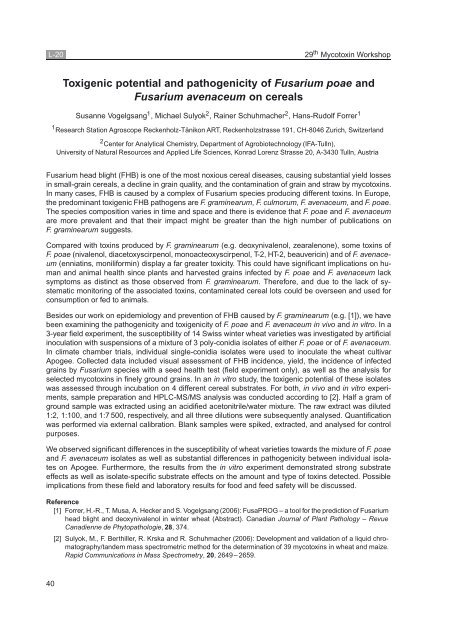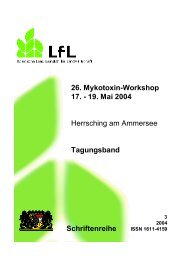Table of Lectures - Society for Mycotoxin Research
Table of Lectures - Society for Mycotoxin Research
Table of Lectures - Society for Mycotoxin Research
You also want an ePaper? Increase the reach of your titles
YUMPU automatically turns print PDFs into web optimized ePapers that Google loves.
L-20 29 th <strong>Mycotoxin</strong> Workshop<br />
Toxigenic potential and pathogenicity <strong>of</strong> Fusarium poae and<br />
Fusarium avenaceum on cereals<br />
Susanne Vogelgsang1 , Michael Sulyok2 , Rainer Schuhmacher2 , Hans-Rudolf Forrer1 1<br />
<strong>Research</strong> Station Agroscope Reckenholz-Tänikon ART, Reckenholzstrasse 191, CH-8046 Zurich, Switzerland<br />
2 Center <strong>for</strong> Analytical Chemistry, Department <strong>of</strong> Agrobiotechnology (IFA-Tulln),<br />
University <strong>of</strong> Natural Resources and Applied Life Sciences, Konrad Lorenz Strasse 20, A-3430 Tulln, Austria<br />
Fusarium head blight (FHB) is one <strong>of</strong> the most noxious cereal diseases, causing substantial yield losses<br />
in small-grain cereals, a decline in grain quality, and the contamination <strong>of</strong> grain and straw by mycotoxins.<br />
In many cases, FHB is caused by a complex <strong>of</strong> Fusarium species producing different toxins. In Europe,<br />
the predominant toxigenic FHB pathogens are F. graminearum, F. culmorum, F. avenaceum, and F. poae.<br />
The species composition varies in time and space and there is evidence that F. poae and F. avenaceum<br />
are more prevalent and that their impact might be greater than the high number <strong>of</strong> publications on<br />
F. graminearum suggests.<br />
Compared with toxins produced by F. graminearum (e.g. deoxynivalenol, zearalenone), some toxins <strong>of</strong><br />
F. poae (nivalenol, diacetoxyscirpenol, monoacteoxyscirpenol, T-2, HT-2, beauvericin) and <strong>of</strong> F. avenaceum<br />
(enniatins, monili<strong>for</strong>min) display a far greater toxicity. This could have significant implications on human<br />
and animal health since plants and harvested grains infected by F. poae and F. avenaceum lack<br />
symptoms as distinct as those observed from F. graminearum. There<strong>for</strong>e, and due to the lack <strong>of</strong> systematic<br />
monitoring <strong>of</strong> the associated toxins, contaminated cereal lots could be overseen and used <strong>for</strong><br />
consumption or fed to animals.<br />
Besides our work on epidemiology and prevention <strong>of</strong> FHB caused by F. graminearum (e.g. [1]), we have<br />
been examining the pathogenicity and toxigenicity <strong>of</strong> F. poae and F. avenaceum in vivo and in vitro. Ina<br />
3-year field experiment, the susceptibility <strong>of</strong> 14 Swiss winter wheat varieties was investigated by artificial<br />
inoculation with suspensions <strong>of</strong> a mixture <strong>of</strong> 3 poly-conidia isolates <strong>of</strong> either F. poae or <strong>of</strong> F. avenaceum.<br />
In climate chamber trials, individual single-conidia isolates were used to inoculate the wheat cultivar<br />
Apogee. Collected data included visual assessment <strong>of</strong> FHB incidence, yield, the incidence <strong>of</strong> infected<br />
grains by Fusarium species with a seed health test (field experiment only), as well as the analysis <strong>for</strong><br />
selected mycotoxins in finely ground grains. In an in vitro study, the toxigenic potential <strong>of</strong> these isolates<br />
was assessed through incubation on 4 different cereal substrates. For both, in vivo and in vitro experiments,<br />
sample preparation and HPLC-MS/MS analysis was conducted according to [2]. Half a gram <strong>of</strong><br />
ground sample was extracted using an acidified acetonitrile/water mixture. The raw extract was diluted<br />
1:2, 1:100, and 1:7 500, respectively, and all three dilutions were subsequently analysed. Quantification<br />
was per<strong>for</strong>med via external calibration. Blank samples were spiked, extracted, and analysed <strong>for</strong> control<br />
purposes.<br />
We observed significant differences in the susceptibility <strong>of</strong> wheat varieties towards the mixture <strong>of</strong> F. poae<br />
and F. avenaceum isolates as well as substantial differences in pathogenicity between individual isolates<br />
on Apogee. Furthermore, the results from the in vitro experiment demonstrated strong substrate<br />
effects as well as isolate-specific substrate effects on the amount and type <strong>of</strong> toxins detected. Possible<br />
implications from these field and laboratory results <strong>for</strong> food and feed safety will be discussed.<br />
Reference<br />
[1] Forrer, H.-R., T. Musa, A. Hecker and S. Vogelgsang (2006): FusaPROG – a tool <strong>for</strong> the prediction <strong>of</strong> Fusarium<br />
head blight and deoxynivalenol in winter wheat (Abstract). Canadian Journal <strong>of</strong> Plant Pathology – Revue<br />
Canadienne de Phytopathologie, 28, 374.<br />
[2] Sulyok, M., F. Berthiller, R. Krska and R. Schuhmacher (2006): Development and validation <strong>of</strong> a liquid chromatography/tandem<br />
mass spectrometric method <strong>for</strong> the determination <strong>of</strong> 39 mycotoxins in wheat and maize.<br />
Rapid Communications in Mass Spectrometry, 20, 2649 – 2659.<br />
40



